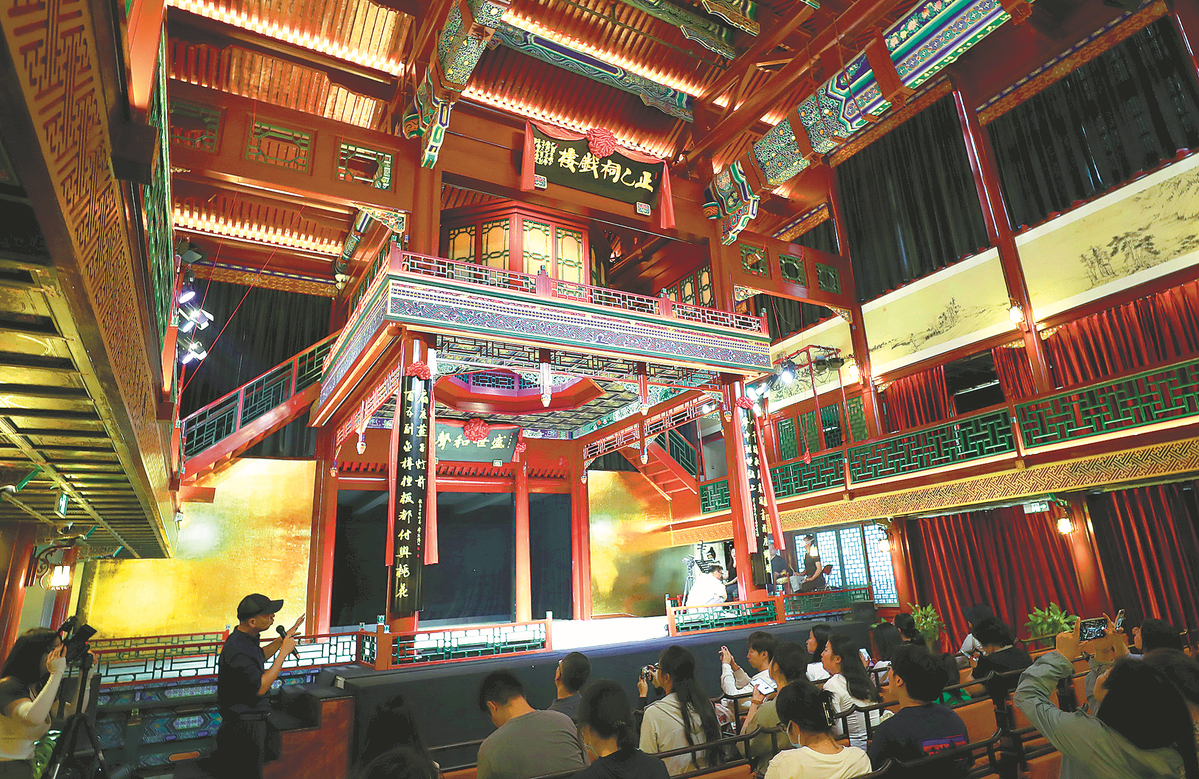



A staff member of the Beijing Temple Theatre introduces the venue to journalists on July 10. Built in 1667, it reopened in April last year and has been presenting Chinese operas. [Photo by Zhang Wei/China Daily]
"It feels so different listening to Peking Opera in such an ancient building," a young fan named Li Xiaolin said after enjoying a show at the Beijing Temple Theatre, whose history spans more than 300 years. "The theater is not big, so the audience is very close to the performers on the stage," she said. "It feels like in the old days. The place has provided a unique experience by linking the past and future, and the traditional and modern."
The theater, located in Beijing's Xicheng district, reopened in April last year after undergoing three years of renovations. The old theater is now endowed with new vitality and vigor. Performances were presented in April this year to celebrate the first anniversary of the reopening. "We renovated the theater with both innovation and security in mind. Eight projectors were installed in different directions to satisfy various theatrical forms, and a fire safety inspection was conducted to ensure that the 300-year-old wooden theater wouldn't be a safety hazard," said Zhang Peng, the theater manager.
The Beijing Temple Theatre, the sole indoor all-wood opera theater in the capital, was built in 1667. It originally presented Kunqu Opera performances and witnessed the development of Peking Opera. It now hosts various performances from both East and West, Zhang said. In the future, the theater will present operas for students and children, aiming to introduce the country's opera history to the young generation.
As the country's cultural center, Beijing has been reusing ancient buildings in recent years, and a lot of architecture in the capital has gained new life since undergoing redesigns and utilizations. Xicheng district has 372 cultural relics protection sites, among which 44 are national-level. "It's our honor and responsibility to protect and inherit those relics," said Liu Dongwei, head of the district. As the pioneer in cultural relics restoration, Xicheng has adopted innovative ideas and invited specialists, professional agencies and the public to join in contributing to protection and reuse. In recent years, the district has invested 4.53 billion yuan ($647 million) to protect 34 sites.
For instance, the Tai'an Li compound, whose history spans nearly 110 years, reopened to the public earlier this year after two years of renovation, having changed from a traditional residence to a culture and arts center. Built in 1914, Tai'an Li is the only preserved shikumen, or multistory terraced house, in the capital.
Wang Xin, vice-president of Riverine China Holdings, which operates the Tai'an Li culture and art center, said Beijing learned about shikumen, also known as lane houses, from Shanghai and brought the architectural style to the capital more than 100 years ago. "The place was the city's 'central business district' during that period," Wang said. "Beijing's first elevator, first taxi as well as many other firsts related to economic development occurred here." Now, those lane houses have been renovated into bookstores, cafes and an arts center, aiming to give visitors a sense of the culture of the past.
"The purpose of utilizing those lane houses is not only to protect them but also to provide public cultural services to society, providing a new choice for residents to be entertained and relax," said Zeng Fang, an official from the culture and tourism bureau in Xicheng. In addition to Tai'an Li, there are 15 old buildings on the list of places to be restored.
Author: Du Juan
Edited by Wang Miao with reference to
<http://www.chinadaily.com.cn/a/202307/18/WS64b5e4aca31035260b816f6f.html>